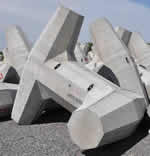Sources: Lakelands Concrete Products, Lima, N.Y.; CP staff
Western New York architectural and utility precast operator Lakelands Concrete has begun shipping 950 16-ton structures for the Corps of Engineers’ Oswego Harbor Detached Breakwater project along Lake Ontario’s southern shore. The individual structures are known as dolos, derived from South African and Latin terms meaning knuckle bone; through weight and geometry, dolosse (plural) quell shoreline erosion from waves and undercurrent.
Assisted by four contract haulers running drop deck trailers, Lakelands Concrete is delivering 30 dolosse per day to the Port of Oswego, with 15 drivers making two deliveries on the 100-mile, plant-to-site route. The lead contractor on the $19 million Corps of Engineers contract, Durocher Marine, has a barge transferring 75 dolosse structures per run. Corps staff has mapped an 850-ft. area of breakwater damaged in October 2012 by the western weather front that morphed into Superstorm Sandy. Each dolos will be placed by sling on a bed of 20-ton limestone segments arriving by rail from Hanson Aggregates’ Jamesville Quarry, near Syracuse, N.Y., and Rock of Ages Quarry in Vermont.
Oswego Harbor is the first Corps contract to use a 16-ton dolos, a structure the agency previously deployed in 8- and 4-ton versions. Lakelands Concrete secured its contract with Durocher Marine in late-2014, committing to an aggressive January–July, eight-piece/day production schedule. The producer enlisted CFC Forms of Pennsylvania to design and fabricate pedestal-mounted forms, with two filling ports and two hinged sections each, to be staged on a main 50- x 300-ft. production bay.
The contract required Lakelands Concrete to finish 750 units prior to dispatching a test dolos to the Port of Oswego. Following the intial lot, up to 100 additional dolosse might be ordered as the contractor and Corps measure unit density attained along the target plot. Software developed in France will be used to monitor the precast structure and limestone bed performance in the face of Lake Ontario waves and currents.
